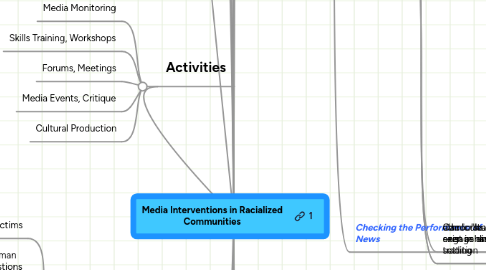
1. Racialized News
1.1. Two weeks after asylum denied, September 11 happened,scrutiny intensifies
1.1.1. war on terrorism begins
1.1.2. "race" themes emerge
1.1.3. "linking" of national news stories caused a clash of civilizations
1.1.3.1. "linking" of news led to catagorizing people as "Middle Eastern"," Muslim", or "Arab".
1.1.3.2. convergence of racialized reporting threatens communities
1.1.3.3. increase of racist violence,discrimination, and harassment
2. Where it Started
2.1. Sydney, Australia-mid 2001
2.1.1. Why?
2.1.1.1. escalation of ethnic crime debates after a series of sexual assaults
2.1.1.2. MV Tampa picked up 438, mainly Afghan asylum seekers.
2.1.1.3. "seekers" denied asylum on Australian soil, transferred to Nauru detention center
3. PURPOSE
3.1. use community based media projects to improve racial discourse among Arab and Muslim communities in Australia
4. Talking Back to News Media
4.1. UMWA organizes a controversial conference
4.2. conference is called Jihad:Terrorism or a Muslim's Highest Aspiration
4.2.1. Strong media presence at conference, yet little media coverage beyond
4.2.2. slanted report appears in The Australian focusing on a quip and ignoring speakers analysis
4.3. Ment to challenge media's use of word "Jihad".
5. Outside the News
5.1. projects that work outside the conventions of news
5.1.1. Radio ArtStart is developed
5.1.1.1. helps young Muslim Australians tell their stories
5.1.1.2. Involves scriptwriting, play acting, and radio dialogues
5.1.1.3. satire, stereotypes, and various background issues were explored
6. Activities
6.1. Media Monitoring
6.2. Skills Training, Workshops
6.3. Forums, Meetings
6.4. Media Events, Critique
6.5. Cultural Production
7. Position Of Participant
7.1. Consumers, Complaints, Victims
7.2. Community Spokesman Responding to Questions
7.3. Professionals promoting access to Valuable story resources
7.4. Critics
7.5. cultural Production
8. News Conventions
8.1. policing, looking for breaches
8.2. work within politics of inclusion
8.3. reproduce and widen-exploit the conventions
8.4. address media institutions
8.5. develop alternatives, address wider publics
9. Different Narratives
9.1. Victim Narratives
9.2. Diversify range of "representative" voices
9.3. Shifting frames, prioritize stories
9.4. victim narratives, political demands
9.5. Irony, appropriate familiar media images to different ends
10. Discourse of Community
10.1. Reproduce
10.2. Diversify Angles of Voices
10.3. Response to racialization in the name of "community".
10.4. Develop alternative discourses
10.5. Develop cultural exchange
11. Community Media Interventions
11.1. meaning
11.1.1. projects developed by communities subjected to media racism to alter or return to mainstream news
11.1.1.1. "intervention"
11.1.1.1.1. highlight the "change" orientation of such activities
11.1.1.1.2. expand, diversify media intentions
11.1.1.1.3. cross the boundary that keeps "ethnic others" confined to community media and specialized journalism
12. Examples
12.1. Checking the Performance of News
12.1.1. monitoring mainstream newsmedia and talk radio
12.1.2. identify examples of irresponsible reporting
12.1.3. reward fair, balanced, and positive coverage
13. Learning the Game
13.1. learning media skills of tolerance
13.2. achieving greater news visibility for community representatives and the issues affecting them
13.3. developing source skills
14. Building Networks
14.1. United Muslim Womens Association
14.1.1. commitment to media interventions and skills workshops for young Muslim women
14.2. Muslim Women's National Network of Australia
14.2.1. focused on educating journalism students, building networks with professional journalists
